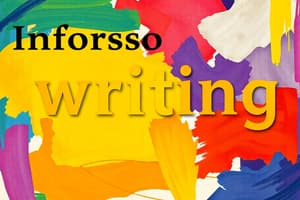Podcast
Questions and Answers
What is the meaning of a tekstong impormatibo?
What is the meaning of a tekstong impormatibo?
A tekstong impormatibo is a type of writing intended to provide information. It offers a clear explanation of the topic being discussed, providing answers to questions like what, when, where, who, and how. In some terminology, it is also called an expository text.
What are the different types of tekstong impormatibo?
What are the different types of tekstong impormatibo?
- Definition (correct)
- Comparison (correct)
- Cause and effect (correct)
- Classification (correct)
What does sanhi at bunga aim to present?
What does sanhi at bunga aim to present?
It aims to illustrate the connection between events, highlighting the direct relationship between the reason for an event (cause) and the outcome (effect).
What does the term paghahambing represent?
What does the term paghahambing represent?
What is the purpose of pagbibigay ng depinisyon?
What is the purpose of pagbibigay ng depinisyon?
What does paglilista ng klasipikasyon aim to do?
What does paglilista ng klasipikasyon aim to do?
What is the purpose of the title of an informative text?
What is the purpose of the title of an informative text?
How is the main idea presented in tekstong impormatibo?
How is the main idea presented in tekstong impormatibo?
What is the function of supporting ideas in tekstong impormatibo?
What is the function of supporting ideas in tekstong impormatibo?
How can visuals be used effectively in informative text?
How can visuals be used effectively in informative text?
What is the importance of highlighting important terms or words in informative texts?
What is the importance of highlighting important terms or words in informative texts?
Why is it important to provide references or sources in informative texts?
Why is it important to provide references or sources in informative texts?
Flashcards
Informative Text
Informative Text
A type of writing that aims to provide information about a specific topic, answering questions like 'what,' 'when,' 'where,' 'who,' and 'how.' It provides clear and concise explanations.
Types of Informative Text
Types of Informative Text
Informative Texts can be structured in different ways, focusing on specific relationships. These structures help present information in a clear and organized manner.
Cause and Effect
Cause and Effect
This type of Informative Text explores the cause and effect relationship between events. It explains why something happened and what resulted from it.
Comparison
Comparison
Signup and view all the flashcards
Definition
Definition
Signup and view all the flashcards
Classification
Classification
Signup and view all the flashcards
Author's Purpose
Author's Purpose
Signup and view all the flashcards
Main Idea
Main Idea
Signup and view all the flashcards
Supporting Ideas
Supporting Ideas
Signup and view all the flashcards
Organizational Markers
Organizational Markers
Signup and view all the flashcards
Visual Representations
Visual Representations
Signup and view all the flashcards
Emphasis on Key Words
Emphasis on Key Words
Signup and view all the flashcards
References and Sources
References and Sources
Signup and view all the flashcards
Reading Comprehension
Reading Comprehension
Signup and view all the flashcards
Main Idea Identification
Main Idea Identification
Signup and view all the flashcards
Author's Purpose Identification
Author's Purpose Identification
Signup and view all the flashcards
Textual Connections
Textual Connections
Signup and view all the flashcards
Inference
Inference
Signup and view all the flashcards
Critical Thinking
Critical Thinking
Signup and view all the flashcards
Author's Perspective
Author's Perspective
Signup and view all the flashcards
Summarization
Summarization
Signup and view all the flashcards
Text Types
Text Types
Signup and view all the flashcards
Information Presentation
Information Presentation
Signup and view all the flashcards
Writing Skills
Writing Skills
Signup and view all the flashcards
Grammar
Grammar
Signup and view all the flashcards
Personal Connection
Personal Connection
Signup and view all the flashcards
Information Literacy
Information Literacy
Signup and view all the flashcards
Study Notes
Informative Text
- Informative text aims to provide information, explaining a topic clearly.
- It answers questions like who, what, when, where, why, and how.
- It's also known as expository text.
Types of Informative Text
- Cause and Effect: Shows the relationship between events where one event causes another.
- Comparison/Contrast: Highlights similarities and differences between subjects.
- Definition: Explains the meaning of a word, term, or concept.
- Classification: Organizes information into categories or groups.
- Listing/Enumeration: Presents a list of items or ideas.
Elements of Informative Text
- Author's Purpose: Explains the author's goal in writing the text.
- Main Idea: The central thought or concept the text discusses.
- Supporting Details: Evidence and examples that support the main idea.
- Organizational Markers: Words or phrases that guide the reader through the information.
- Visual Aids: Charts, diagrams, and other graphics that help to understand information.
- Style and Language: Formal language and vocabulary commonly used to convey information in a specific subject matter, and a clear style ensures a proper structure.
- Citations and Sources: Any sources referenced are properly cited to give credit and build credibility.
Studying That Suits You
Use AI to generate personalized quizzes and flashcards to suit your learning preferences.




